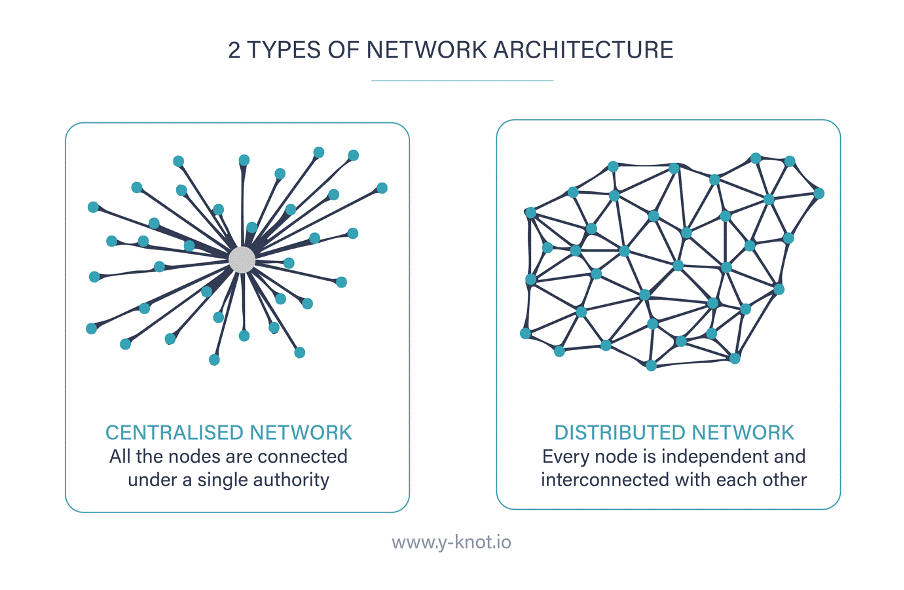Decentralisation
Decentralised Networks
Decentralisation and decentralised networks can be compared to the ocean – it offers endless possibility and freedom of choice. Decentralisation puts the power in the hands of many; distributing the power among all the members of the community (or network).
Blockchain technology, cryptos, smart contracts and NFTs all rely on the concept of decentralisation. Before defining decentralisation, let us take a step back and start with centralisation.
What is decentralisation?
Our daily interactions with the world is by the most part centralised. Only a few have the authority to make decisions that have a direct impact on us. Take for example our entire financial and legal system, which is mostly controlled by the government, authorised banks, and law firms. In some organisations, decisions are made by only a few members of the board. Giants like Google and Facebook, used by billions around the world, have the power to decide what they want their users to see.
Centralisation relies heavily on a trusted intermediary. The public wants to know these companies and organisations have their best interest in mind. This is not always the case, which gave rise to a fleet of anti-trust lawsuits. Companies like eBay and Amazon act as trusted intermediaries that ensure goods are distributed between sellers and buyers.
Governments have historically cooperated with these trusted intermediaries, (also called "choke points"), in our global economy to avoid unwanted outcomes such as tax evasion, and money-laundering through reporting on suspicious activity [1]. Banks and other organisations need to file reports and disclose information to governing bodies about these suspicious activities.
On the other side of the pendulum we have decentralisation. Decentra-lisation and decentralised networks can be compared to the ocean – it offers endless possibility and freedom of choice.
Decentralisation puts the power in the hands of many; distributing the power among all the members of the community (or network). Bitcoin is an example where there is no need for a centralised bank or any intermediary because all the transactions are visible to all the parties involved and the blockchain keeps the transaction history, which allows anyone in the network to trace back any transaction to its origin.
The figure below is an illustration of the difference between a centralised network architecture and a distributed network architecture. In a centralised network, all the nodes need to communicate through (and are governed by) a single trusted node. Decentralisation removes the need for a trusted intermediary or central authority, to achieve the same functionality with the same amount of certainty (trust).

With the introduction of blockchain, trustless networks have been made possible, since parties can transact directly with each, even though they do not know (trust) each other. The absence of a trusted (centralised) intermediary means faster reconciliation between the transacting parties.
In the context of blockchain-based technology, “trustless” points towards the idea that people (strangers) can transact with one another even if they don’t trust or know each other – all because the blockchain-based network establishes a culture of trust in the system, therefore trustworthy. And so a trustworthy network enables you to buy, invest and sell with peace of mind, knowing that the system is absolutely reliable.
Trustworthy solutions that allow for trustless transactions.
If decentralisation is new to you, you may still have a lot of questions as to how this really works and proof of the trustworthiness of blockchain-based solutions. Blockchain and decentralisation rely on cryptography which brings authoritativeness behind all the interactions in the network. Cryptography and network security aim to provide the trust and security needed to build our trust in the system. In the next section we will explore cryptography.
This section was written for educational purposes by Yknot Blockchain Solutions. We know the ropes when it comes to building blockchain-based solutions. Contact us to get all hands on deck for your next expedition.
References
[1] J. Maupin, "Mapping the Global Legal Landscape of Blockchain and Other Distributed Ledger Technologies", Cigionline.org, 2017. [Online]. Available: https://www.cigionline.org/static/documents/documents/Paper%20no.149.pdf. [Accessed: 10- Jun- 2021].